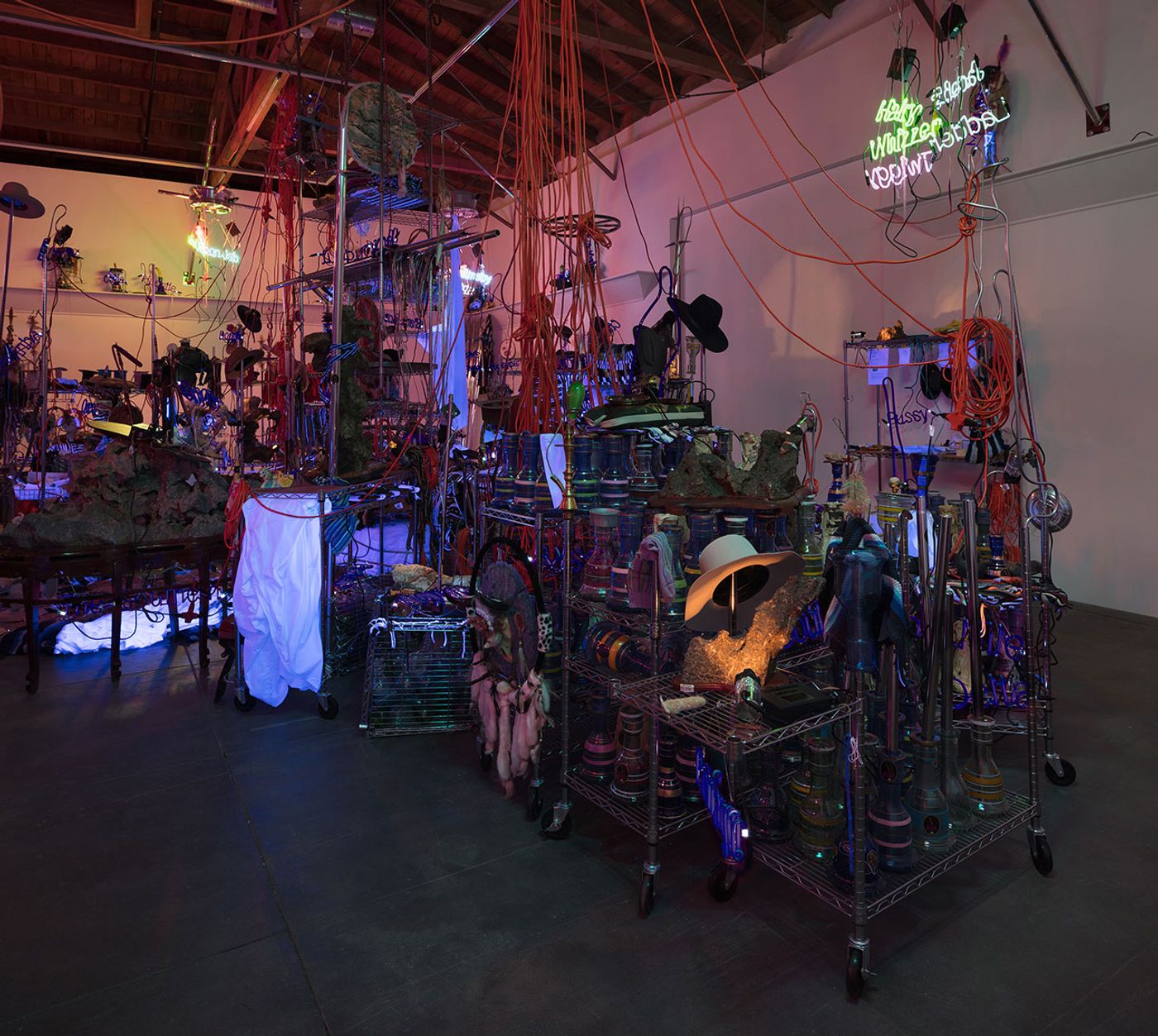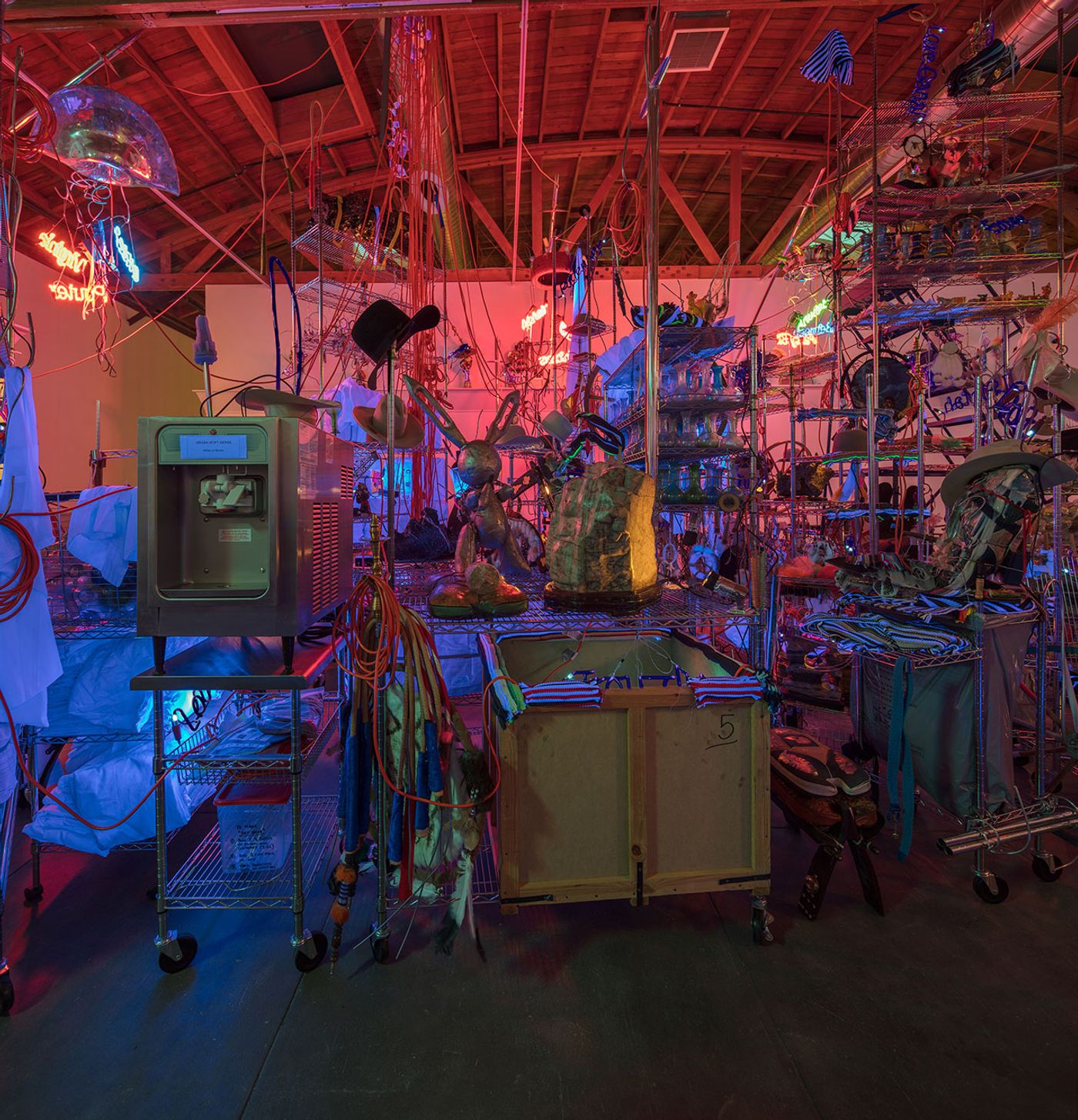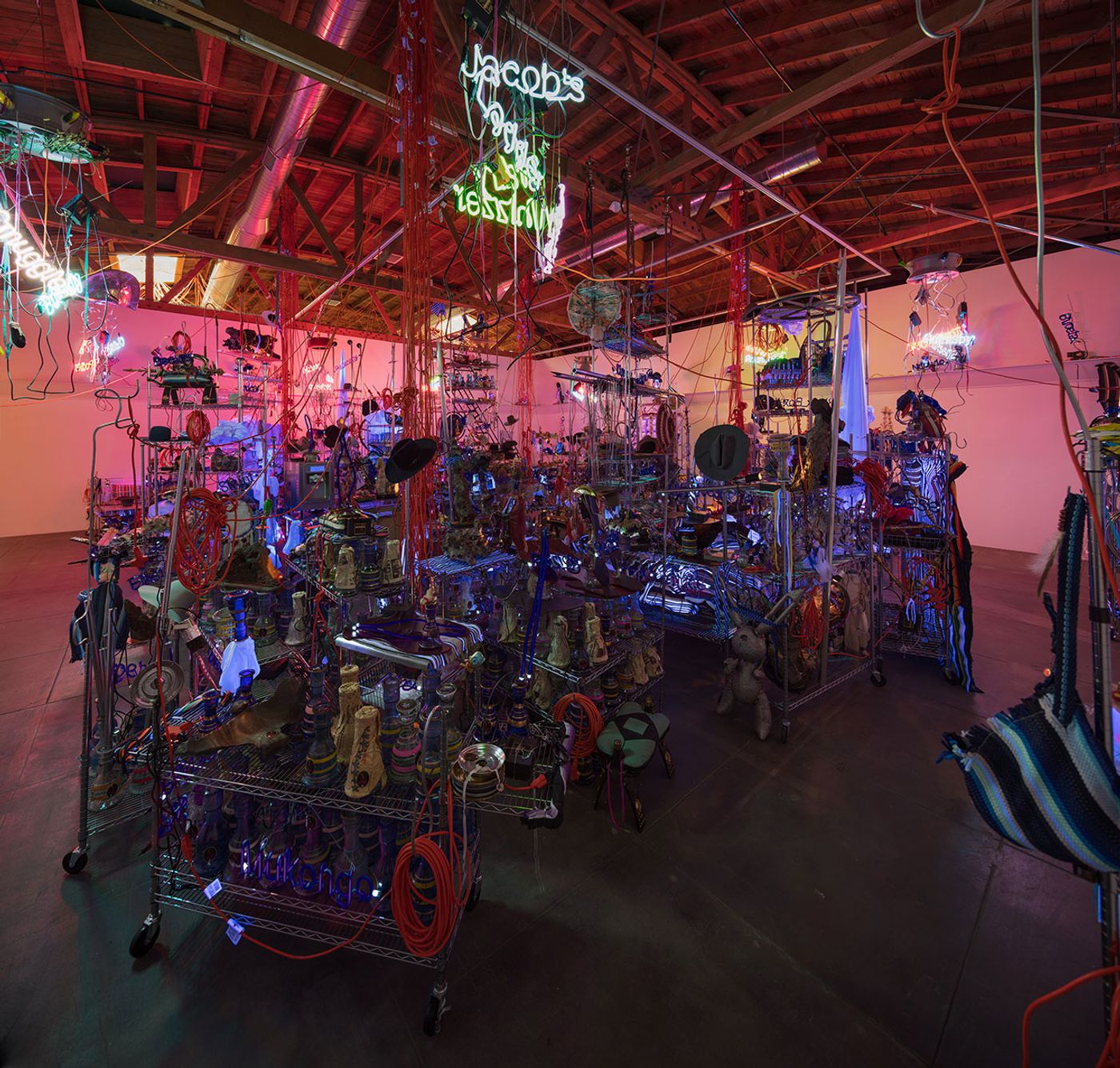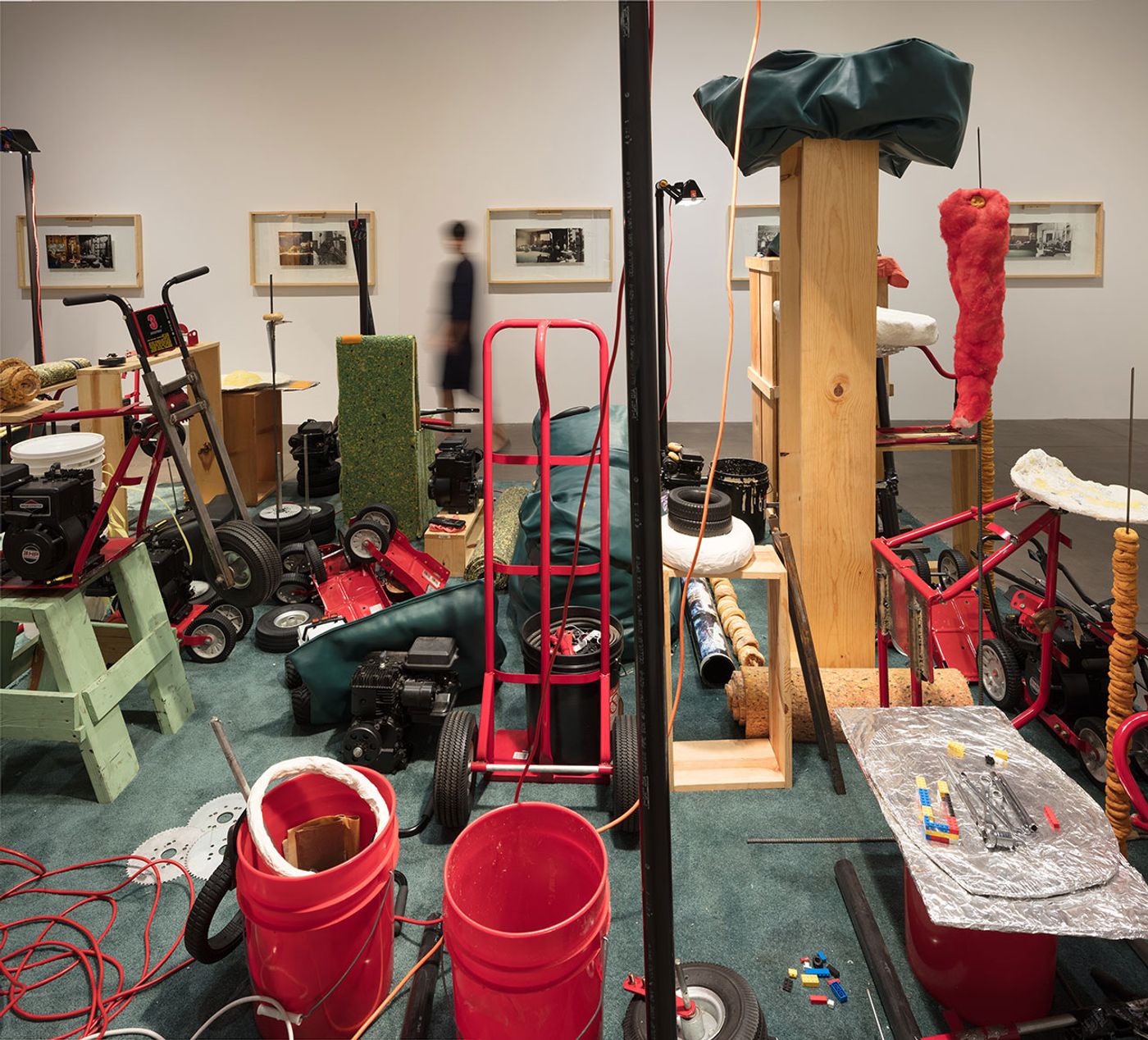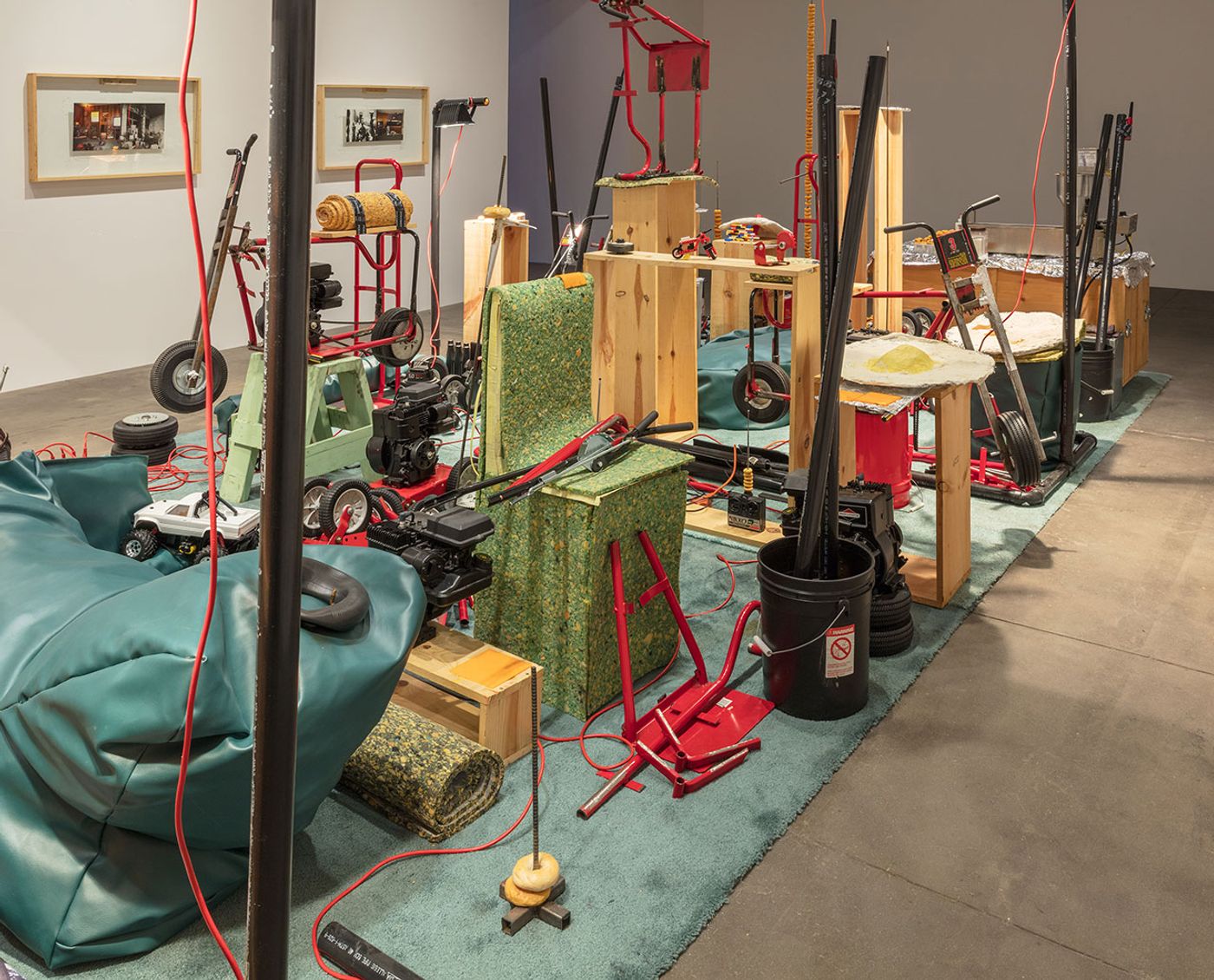
Jason Rhoades' Brilliant Installations at Hauser & Wirth Los Angeles
Words by Eric David
Location
Los Angeles, California, United States
Jason Rhoades' Brilliant Installations at Hauser & Wirth Los Angeles
Words by Eric David
Los Angeles, California, United States
Los Angeles, California, United States
Location
If the goal of art is to speak of the contemporary and the topical then the litmus test of great art is the ability to keep speaking long after its creation, a test the work of American artist Jason Rhoades passes in flying colors, literally as it turns out, courtesy of Hauser & Wirth in Los Angeles. Opened in February and lasting until May 21st, “Jason Rhoades. Installations, 1994 – 2006” is the first major exhibition in the city where the artist—who died in 2006, aged 41, of an accidental overdose— lived and worked. Characterized by mad exuberance, provocative iconoclasm and unapologetic maximalism, Rhoades' work, which has no qualms for example blending Islam with female genitalia, seems more relevant than ever in the age of Trump.
As the exhibition’s name suggests, Rhoades' oeuvre consists of large-scale installations, six of which are showcased in the gallery’s 2,600 square meter space. Spanning two decades, the installations have been carefully selected by curator Paul Schimmel to exemplify the major themes that Rhoades tackled in his art: racial and gender stereotypes, politics, religion and sex, the combination of the last two being an incendiary cocktail that, far from shying away from, the artist boldly embraced in his career-long defiance of cultural conventions and public nicety. Rhoades’ installations—chaotic, jam-packed, mass assemblages of grandiose proportions that art critic Jerry Saltz has eloquently named “clusterfuck aesthetics”—at first bewilder and mystify the viewer but gradually reveal hidden references amidst their intricate cacophony.

Jason Rhoades, Tijuanatanjierchandelier, 2006. Mixed media. Dimensions variable. Installation view, ‘Jason Rhoades. Installations, 1994 – 2006’, Hauser & Wirth Los Angeles, 2017. © The Estate of Jason Rhoades. Courtesy the estate, Hauser & Wirth, David Zwirner and lender. Photo by Fredrik Nilsen.

Jason Rhoades, Tijuanatanjierchandelier, 2006. Mixed media. Dimensions variable. Installation view, ‘Jason Rhoades. Installations, 1994 – 2006’, Hauser & Wirth Los Angeles, 2017. © The Estate of Jason Rhoades. Courtesy the estate, Hauser & Wirth, David Zwirner and lender. Photo by Fredrik Nilsen.

Jason Rhoades, Tijuanatanjierchandelier, 2006. Mixed media. Dimensions variable. Installation view, ‘Jason Rhoades. Installations, 1994 – 2006’, Hauser & Wirth Los Angeles, 2017. © The Estate of Jason Rhoades. Courtesy the estate, Hauser & Wirth, David Zwirner and lender. Photo by Fredrik Nilsen.

Jason Rhoades, Tijuanatanjierchandelier, 2006. Mixed media. Dimensions variable. Installation view, ‘Jason Rhoades. Installations, 1994 – 2006’, Hauser & Wirth Los Angeles, 2017. © The Estate of Jason Rhoades. Courtesy the estate, Hauser & Wirth, David Zwirner and lender. Photo by Fredrik Nilsen.

Jason Rhoades, Tijuanatanjierchandelier, 2006. Mixed media. Dimensions variable. Installation view, ‘Jason Rhoades. Installations, 1994 – 2006’, Hauser & Wirth Los Angeles, 2017. © The Estate of Jason Rhoades. Courtesy the estate, Hauser & Wirth, David Zwirner and lender. Photo by Fredrik Nilsen.
Rhoades’ works from the nineties, “Swedish Erotica and Fiero Parts” (1994), “My Brother/Brancuzi” (1995) and “The Creation Myth” (1998), demonstrate his brash, tongue-in-cheek approach from the beginning of his career—Rhoades completed his art studies at UCLA in 1993—perfectly capturing the rampant consumerism and the networking possibilities of the, then nascent, internet age. In “Swedish Erotica and Fiero Parts”, Rhoades created his own version of IKEA’s modular furniture out of scraps of paper, wood, cardboard and plastic foam. Meanwhile, in “My Brother/Brancuzi”, he juxtaposed his brother’s suburban bedroom with the famous studio of Constantin Brâncuși by lining the walls of the gallery with framed photo collages and amassing an array of construction materials, power tools and weightlifting equipment, including an industrial fryer overflowing with doughnuts—a slender stack of which alludes to Brâncuși’s “Endless Column”. When compared to Brâncuși’s reductive forms, the assembled items and symbols of masculine endeavor, lose their heroic aspect and appear caricatured and forlorn.
In “The Creation Myth”, Rhoades explores the myths and narratives about our creation, touching upon both Creationist and Evolutionist theories, by metaphorically portraying “The Mind, the Body and the Spirit, the Shit, Prick and the Rebellious Part” (conveniently the work’s subtitle). Assembled with readymade and manmade products including stacked tables, mirrors, plastic buckets and discarded consumer electronics, this is a work of multiple, whimsical narratives, where a train of thought literally circles the installation, a large red fabric tube-cum-oesophagus twists over the “corpus” and a smoke machine puffs ghostly rings every two-and-a-half minutes, with a note cheekily informing visitors that “Yes, I can blow smoke rings out my asshole.”

Jason Rhoades, Swedish Erotica and Fiero Parts, 1994. Mixed media. Dimensions variable. Installation view, ‘Jason Rhoades. Installations, 1994 – 2006’. Hauser & Wirth Los Angeles, 2017 © The Estate of Jason Rhoades. Courtesy the estate, Hauser & Wirth, Private Collection, Switzerland and lenders. Photo by Fredrik Nilsen.

Jason Rhoades, Swedish Erotica and Fiero Parts, 1994. Mixed media. Dimensions variable. Installation view, ‘Jason Rhoades. Installations, 1994 – 2006’. Hauser & Wirth Los Angeles, 2017 © The Estate of Jason Rhoades. Courtesy the estate, Hauser & Wirth, Private Collection, Switzerland and lenders. Photo by Fredrik Nilsen.

Jason Rhoades, Swedish Erotica and Fiero Parts, 1994. Mixed media. Dimensions variable. Installation view, ‘Jason Rhoades. Installations, 1994 – 2006’. Hauser & Wirth Los Angeles, 2017 © The Estate of Jason Rhoades. Courtesy the estate, Hauser & Wirth, Private Collection, Switzerland and lenders. Photo by Fredrik Nilsen.

Jason Rhoades, Swedish Erotica and Fiero Parts, 1994. Mixed media. Dimensions variable. Installation view, ‘Jason Rhoades. Installations, 1994 – 2006’. Hauser & Wirth Los Angeles, 2017 © The Estate of Jason Rhoades. Courtesy the estate, Hauser & Wirth, Private Collection, Switzerland and lenders. Photo by Fredrik Nilsen.
Rhoades’ major preoccupation in the noughties can be summed as a search for the “ultimate pussy word”, a quest that amassed over 7,000 words that describe the female genitalia, drawn from African, Creole, Cajun, Ebonics and Hip-Hop dialects and whose findings are showcased in all three of his installations from that period: “My Madinah. In pursuit of my ermitage...” (2004), “The Black Pussy... and the Pagan Idol Workshop” (2005) and “Tijuanatanjierchandelier” (2006)—their titles also revealing the artist’s affection for word play.
“My Madinah. In pursuit of my ermitage...” was conceived as a mosque, a place of quiet contemplation, dedicated not to an almighty deity but rather to female genitalia. Walking over an array of cheap towels in lieu of prayer rugs, clumsily stitched together by the artist’s Spukaki technique, the visitor is overwhelmed by a cloud of 240 neon slang words for pussy such as “Satan’s cave”, “magic handbag” and “yoyo smuggle”. Borrowing from the visual language of western culture and the holy sites of Islam to explore taboos and post-9/11 Islamophobia, the piece is both very public in its references and at the same time very personal as it embodies the artist’s own version of spiritual development.

Jason Rhoades, My Madinah. In pursuit of my ermitage..., 2004. Mixed media. Dimensions variable. Installation view, ‘Jason Rhoades. Installations, 1994 – 2006’. Hauser & Wirth Los Angeles, 2017 © The Estate of Jason Rhoades. Courtesy the estate, Hauser & Wirth and David Zwirner. Photo by Fredrik Nilsen.

Jason Rhoades, My Madinah. In pursuit of my ermitage..., 2004. Mixed media. Dimensions variable. Installation view, ‘Jason Rhoades. Installations, 1994 – 2006’. Hauser & Wirth Los Angeles, 2017 © The Estate of Jason Rhoades. Courtesy the estate, Hauser & Wirth and David Zwirner. Photo by Fredrik Nilsen.

Jason Rhoades, My Madinah. In pursuit of my ermitage..., 2004. Mixed media. Dimensions variable. Installation view, ‘Jason Rhoades. Installations, 1994 – 2006’. Hauser & Wirth Los Angeles, 2017 © The Estate of Jason Rhoades. Courtesy the estate, Hauser & Wirth and David Zwirner. Photo by Fredrik Nilsen.

Jason Rhoades, My Madinah. In pursuit of my ermitage..., 2004. Mixed media. Dimensions variable. Installation view, ‘Jason Rhoades. Installations, 1994 – 2006’. Hauser & Wirth Los Angeles, 2017 © The Estate of Jason Rhoades. Courtesy the estate, Hauser & Wirth and David Zwirner. Photo by Fredrik Nilsen.
Islam and female genitalia are also referenced in “The Black Pussy... and the Pagan Idol Workshop” which was inspired by the pre-Islamic story of the Kaaba: once a repository of pagan idols, it was turned into Islam's most sacred site when Muhammad rededicated it to Allah. For this installation, Rhoades has recreated 360 idols that were banished from Kaaba, and mixed them together with Egyptian-made hookah pipes, Native American dream catchers, beaver-felt cowboy hats, a collection of ancient Chinese gongshi stones and, as in the previous work, slang terms for vagina in neon. The piece feels like a cross between an abandoned, polytheistic shrine and a flea market, alluding to the intersection of religion and commerce, where the intrinsic value of banished idols, amulets, talismans and censored words is a matter of supply and demand.
Finally, in “Tijuanatanjierchandelier”, his last piece before his death, Rhoades swaps the holy site for the market place—the concepts are almost interchangeable in the artist’s universe—creating a bazaar out of blankets full of wares bought in Tijuana, Mexico and Tangier, Morocco, accompanied by a cluster of tangled chandeliers of fake maracas, sombreros, bogus designer handbags, Moroccan hanging lights and other “exotic” souvenirs from the two border towns. Despite the cultural and geographical distance that separates them, the installation alludes to the similar ways in which their disparate cultures have been commercialized and homogenized in a globalized environment. Once again, 176 neon “pussy words” in English or Spanish glow seductively amidst the suspended tchotchkes; after all, Rhoades considered his separate works as components of one single piece realized over time and this retrospective exhibition monumentally attests to that.

Jason Rhoades, My Madinah. In pursuit of my ermitage..., 2004. Mixed media. Dimensions variable. Installation view, ‘Jason Rhoades. Installations, 1994 – 2006’. Hauser & Wirth Los Angeles, 2017 © The Estate of Jason Rhoades. Courtesy the estate, Hauser & Wirth and David Zwirner. Photo by Fredrik Nilsen.

Jason Rhoades, The Creation Myth,
1998. Mixed media. Dimensions variable. Installation view, ‘Jason Rhoades. Installations, 1994 – 2006’. Hauser & Wirth Los Angeles, 2017 © The Estate of Jason Rhoades. Courtesy Friedrich Christian Flick Collection im Hamburger Bahnhof, Berlin. Photo by Fredrik Nilsen.

Jason Rhoades, The Creation Myth,
1998. Mixed media. Dimensions variable. Installation view, ‘Jason Rhoades. Installations, 1994 – 2006’. Hauser & Wirth Los Angeles, 2017 © The Estate of Jason Rhoades. Courtesy Friedrich Christian Flick Collection im Hamburger Bahnhof, Berlin. Photo by Fredrik Nilsen.

Jason Rhoades, The Creation Myth,
1998. Mixed media. Dimensions variable. Installation view, ‘Jason Rhoades. Installations, 1994 – 2006’. Hauser & Wirth Los Angeles, 2017 © The Estate of Jason Rhoades. Courtesy Friedrich Christian Flick Collection im Hamburger Bahnhof, Berlin. Photo by Fredrik Nilsen.

Jason Rhoades, The Creation Myth,
1998. Mixed media. Dimensions variable. Installation view, ‘Jason Rhoades. Installations, 1994 – 2006’. Hauser & Wirth Los Angeles, 2017 © The Estate of Jason Rhoades. Courtesy Friedrich Christian Flick Collection im Hamburger Bahnhof, Berlin. Photo by Fredrik Nilsen.

Jason Rhoades, My Brother / Brancuzi, 1995. Mixed media. Dimensions variable. Installation view, ‘Jason Rhoades. Installations, 1994 – 2006’. Hauser & Wirth Los Angeles, 2017 © The Estate of Jason Rhoades. Courtesy Private Collection, Switzerland. Photo by Fredrik Nilsen.

Jason Rhoades, My Brother / Brancuzi, 1995. Mixed media. Dimensions variable. Installation view, ‘Jason Rhoades. Installations, 1994 – 2006’. Hauser & Wirth Los Angeles, 2017 © The Estate of Jason Rhoades. Courtesy Private Collection, Switzerland. Photo by Fredrik Nilsen.

Jason Rhoades, My Brother / Brancuzi, 1995. Mixed media. Dimensions variable. Installation view, ‘Jason Rhoades. Installations, 1994 – 2006’. Hauser & Wirth Los Angeles, 2017 © The Estate of Jason Rhoades. Courtesy Private Collection, Switzerland. Photo by Fredrik Nilsen.

Jason Rhoades, My Brother / Brancuzi, 1995. Mixed media. Dimensions variable. Installation view, ‘Jason Rhoades. Installations, 1994 – 2006’. Hauser & Wirth Los Angeles, 2017 © The Estate of Jason Rhoades. Courtesy Private Collection, Switzerland. Photo by Fredrik Nilsen.

Jason Rhoades, My Brother / Brancuzi, 1995. Mixed media. Dimensions variable. Installation view, ‘Jason Rhoades. Installations, 1994 – 2006’. Hauser & Wirth Los Angeles, 2017 © The Estate of Jason Rhoades. Courtesy Private Collection, Switzerland. Photo by Fredrik Nilsen.
